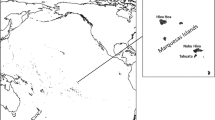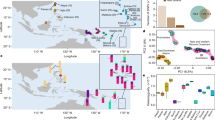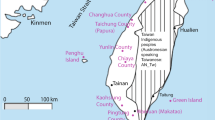Abstract
The island region at the southeastern-most tip of New Guinea and its inhabitants known as Massim are well known for a unique traditional inter-island trading system, called Kula or Kula Ring. To characterize the Massim genetically, and to evaluate the influence of the Kula Ring on patterns of human genetic variation, we analyzed paternally inherited Y-chromosome (NRY) and maternally inherited mitochondrial (mt) DNA polymorphisms in >400 individuals from this region. We found that the nearly exclusively Austronesian-speaking Massim people harbor genetic ancestry components of both Asian (AS) and Near Oceanian (NO) origin, with a proportionally larger NO NRY component versus a larger AS mtDNA component. This is similar to previous observations in other Austronesian-speaking populations from Near and Remote Oceania and suggests sex-biased genetic admixture between Asians and Near Oceanians before the occupation of Remote Oceania, in line with the Slow Boat from Asia hypothesis on the expansion of Austronesians into the Pacific. Contrary to linguistic expectations, Rossel Islanders, the only Papuan speakers of the Massim, showed a lower amount of NO genetic ancestry than their Austronesian-speaking Massim neighbors. For the islands traditionally involved in the Kula Ring, a significant correlation between inter-island travelling distances and genetic distances was observed for mtDNA, but not for NRY, suggesting more male- than female-mediated gene flow. As traditionally only males take part in the Kula voyages, this finding may indicate a genetic signature of the Kula Ring, serving as another example of how cultural tradition has shaped human genetic diversity.
Similar content being viewed by others
Log in or create a free account to read this content
Gain free access to this article, as well as selected content from this journal and more on nature.com
or
References
Hurles ME, Matisoo-Smith E, Gray RD, Penny D : Untangling Oceanic settlement: the edge of the knowable. Trends Ecol Evol 2003; 18: 531–540.
Kayser M : The human genetic history of Oceania: near and remote views of dispersal. Curr Biol 2010; 20: R194–R201.
Sykes B, Leiboff A, Low-Beer J, Tetzner S, Richards M : The origins of the Polynesians: an interpretation from mitochondrial lineage analysis. Am J Hum Genet 1995; 57: 1463–1475.
Kayser M, Brauer S, Weiss G et al: Melanesian origin of Polynesian Y chromosomes. Curr Biol 2000; 10: 1237–1246.
Su B, Jin L, Underhill P et al: Polynesian origins: insights from the Y chromosome. Proc Natl Acad Sci U S A 2000; 97: 8225–8228.
Hurles ME, Nicholson J, Bosch E, Renfrew C, Sykes BC, Jobling MA : Y chromosomal evidence for the origins of Oceanic-speaking peoples. Genetics 2002; 160: 289–303.
Kayser M, Brauer S, Cordaux R et al: Melanesian and Asian origins of Polynesians: mtDNA and Y chromosome gradients across the Pacific. Mol Biol Evol 2006; 23: 2234–2244.
Soares P, Rito T, Trejaut J et al: Ancient voyaging and Polynesian origins. Am J Hum Genet 2011; 88: 239–247.
Stoneking M, Jorde LB, Bhatia K, Wilson AC : Geographic variation in human mitochondrial DNA from Papua New Guinea. Genetics 1990; 124: 717–733.
Tommaseo-Ponzetta M, Attimonelli M, De Robertis M, Tanzariello F, Saccone C : Mitochondrial DNA variability of West New Guinea populations. Am J Phys Anthropol 2002; 117: 49–67.
Kayser M, Brauer S, Weiss G et al: Reduced Y-chromosome, but not mitochondrial DNA, diversity in human populations from West New Guinea. Am J Hum Genet 2003; 72: 281–302.
Mona S, Tommaseo-Ponzetta M, Brauer S, Sudoyo H, Marzuki S, Kayser M : Patterns of Y-chromosome diversity intersect with the Trans-New Guinea hypothesis. Mol Biol Evol 2007; 24: 2546–2555.
Vilar MG, Kaneko A, Hombhanje FW, Tsukahara T, Hwaihwanje I, Lum JK : Reconstructing the origin of the Lapita Cultural Complex: mtDNA analyses of East Sepik Province, PNG. J Hum Genet 2008; 53: 698–708.
Scheinfeldt L, Friedlaender F, Friedlaender J et al: Unexpected NRY chromosome variation in Northern Island Melanesia. Mol Biol Evol 2006; 23: 1628–1641.
Friedlaender JS, Friedlaender FR, Hodgson JA et al: Melanesian mtDNA complexity. PloS One 2007; 2: e248.
Kayser M, Choi Y, van Oven M et al: The impact of the Austronesian expansion: evidence from mtDNA and Y chromosome diversity in the Admiralty Islands of Melanesia. Mol Biol Evol 2008; 25: 1362–1374.
Cox MP, Mirazón Lahr M : Y-chromosome diversity is inversely associated with language affiliation in paired Austronesian- and Papuan-speaking communities from Solomon Islands. Am J Hum Biol 2006; 18: 35–50.
Delfin F, Myles S, Choi Y et al: Bridging near and remote Oceania: mtDNA and NRY variation in the Solomon Islands. Mol Biol Evol 2012; 29: 545–564.
Hamy ET : Étude sur les Papouas de la mer d’Entrecasteaux. Rev Ethnogr 1888; 7: 503–519.
Haddon AC : The Decorative Art of British New Guinea: A Study in Papuan Ethnography. Dublin: Academy House, 1894.
Seligmann CG : A classification of the natives of British New Guinea. J R Anthropol Inst G B Irel 1909; 39: 246–275.
Young MW : The Massim: an introduction. J Pac Hist 1983; 18: 4–10.
Lum JK, Jorde LB, Schiefenhovel W : Affinities among Melanesians, Micronesians, and Polynesians: a neutral biparental genetic perspective. Hum Biol 2002; 74: 413–430.
Summerhayes GR, Leavesley M, Fairbairn A et al: Human adaptation and plant use in highland New Guinea 49,000 to 44,000 years ago. Science 2010; 330: 78–81.
Wickler S, Spriggs M : Pleistocene human occupation of the Solomon Islands, Melanesia. Antiquity 1988; 62: 703–706.
Kirch PV : Prehistoric exchange in western Melanesia. Annu Rev Anthropol 1991; 20: 141–165.
Irwin G : Themes in the prehistory of coastal Papua and the Massim; in Pawley A (ed): Man and a Half: Essays in Pacific Anthropology and Ethnobiology in Honour of Ralf Bulmer. Auckland: The Polynesian Society, 1991, pp 503–510.
Bickler SH : Prehistoric stone monuments in the northern region of the Kula Ring. Antiquity 2006; 80: 38–51.
Voris HK : Maps of Pleistocene sea levels in Southeast Asia: shorelines, river systems and time durations. J Biogeogr 2000; 27: 1153–1167.
Ross M : Proto Oceanic and the Austronesian Languages of Western Melanesia. Canberra: Australian National University, 1988.
Henderson JA : Yeletnye, the language of Rossel Island; in Dutton TE (ed): Studies in the Languages of Central and South-East Papua. Pacific Linguistics. Canberra: Australian National University, 1975, pp 817–834.
Malinowski B : Kula; the circulating exchange of valuables in the archipelagoes of eastern New Guinea. Man 1920; 20: 97–105.
Malinowksi B : Argonauts of the Western Pacific; An Account of Native Enterprise and Adventure in the Archipelagoes of Melanesian New Guinea, 1978 reprint edition London and Henley: Routledge & Kegan Paul, 1922.
Landa JT : The enigma of the Kula Ring: gift-exchanges and primitive law and order. Int Rev Law Econ 1983; 3: 137–160.
Leach J, Leach E : The Kula: New Perspectives on Massim Exchange. Cambridge: Cambridge University Press, 1983.
Macintyre M : The Kula: A Bibliography. Cambridge: Cambridge University Press, 1983.
Ziegler R : The Kula Ring of Bronislaw Malinowski: co-evolution of an economic and ceremonial exchange system. Rev Eur Stud 2012; 4: 15–27.
Rynkiewich MA : The world in my parish: rethinking the standard missiological model. Missiology 2002; 30: 301.
Oota H, Settheetham-Ishida W, Tiwawech D, Ishida T, Stoneking M : Human mtDNA and Y-chromosome variation is correlated with matrilocal versus patrilocal residence. Nat Genet 2001; 29: 20–21.
Pemberton TJ, Li F-Y, Hanson EK et al: Impact of restricted marital practices on genetic variation in an endogamous Gujarati group. Am J Phys Anthropol 2012; 149: 92–103.
Armstrong WE : Rossel Island: An Ethnological Study. Cambridge: Cambridge University Press, 1928.
Mona S, Grunz KE, Brauer S et al: Genetic admixture history of Eastern Indonesia as revealed by Y-chromosome and mitochondrial DNA analysis. Mol Biol Evol 2009; 26: 1865–1877.
van Oven M, Hämmerle JM, van Schoor M et al: Unexpected island effects at an extreme: reduced Y chromosome and mitochondrial DNA diversity in Nias. Mol Biol Evol 2011; 28: 1349–1361.
Miller SA, Dykes DD, Polesky HF : A simple salting out procedure for extracting DNA from human nucleated cells. Nucleic Acids Res 1988; 16: 1215.
Ballantyne KN, van Oven M, Ralf A et al: MtDNA SNP multiplexes for efficient inference of matrilineal genetic ancestry within Oceania. Forensic Sci Int Genet 2012; 6: 425–436.
Karafet TM, Mendez FL, Meilerman MB, Underhill PA, Zegura SL, Hammer MF : New binary polymorphisms reshape and increase resolution of the human Y chromosomal haplogroup tree. Genome Res 2008; 18: 830–838.
van Oven M, Kayser M : Updated comprehensive phylogenetic tree of global human mitochondrial DNA variation. Hum Mutat 2009; 30: E386–E394.
Excoffier L, Lischer HEL : Arlequin suite ver 3.5: a new series of programs to perform population genetics analyses under Linux and Windows. Mol Ecol Resour 2010; 10: 564–567.
Busing FMTA, Commandeur JJF, Heiser WJ : PROXSCAL: a multidimensional scaling program for individual differences scaling with constraints; in Bandilla W, Faulbaum F (eds): SoftStat ’97: Advances in Statistical Software 6. Stuttgart: Lucius & Lucius, 1997, pp 67–74.
Bandelt HJ, Forster P, Röhl A : Median-joining networks for inferring intraspecific phylogenies. Mol Biol Evol 1999; 16: 37–48.
Kong Q-P, Yao Y-G, Sun C, Bandelt H-J, Zhu C-L, Zhang Y-P : Phylogeny of East Asian mitochondrial DNA lineages inferred from complete sequences. Am J Hum Genet 2003; 73: 671–676.
Trejaut JA, Kivisild T, Loo JH et al: Traces of archaic mitochondrial lineages persist in Austronesian-speaking Formosan populations. PLoS Biol 2005; 3: e247.
Melton T, Peterson R, Redd AJ et al: Polynesian genetic affinities with Southeast Asian populations as identified by mtDNA analysis. Am J Hum Genet 1995; 57: 403–414.
Redd AJ, Takezaki N, Sherry ST, McGarvey ST, Sofro AS, Stoneking M : Evolutionary history of the COII/tRNALys intergenic 9 base pair deletion in human mitochondrial DNAs from the Pacific. Mol Biol Evol 1995; 12: 604–615.
Richards M, Oppenheimer S, Sykes B : MtDNA suggests Polynesian origins in Eastern Indonesia. Am J Hum Genet 1998; 63: 1234–1236.
Soares P, Trejaut JA, Loo J-H et al: Climate change and postglacial human dispersals in southeast Asia. Mol Biol Evol 2008; 25: 1209–1218.
Friedlaender J, Schurr T, Gentz F et al: Expanding Southwest Pacific mitochondrial haplogroups P and Q. Mol Biol Evol 2005; 22: 1506–1517.
Hill C, Soares P, Mormina M et al: A mitochondrial stratigraphy for Island Southeast Asia. Am J Hum Genet 2007; 80: 29–43.
Peng M-S, Quang HH, Dang KP et al: Tracing the Austronesian footprint in Mainland Southeast Asia: a perspective from mitochondrial DNA. Mol Biol Evol 2010; 27: 2417–2430.
Wollstein A, Lao O, Becker C et al: Demographic history of Oceania inferred from genome-wide data. Curr Biol CB 2010; 20: 1983–1992.
Key CA : Pottery manufacture in the Wanigela area of Collingwood Bay, Papua. Mankind 2009; 6: 653–657.
Egloff BJ : The Kula before Malinowski: a changing configuration. Mankind 2010; 11: 429–435.
Acknowledgements
We thank all DNA donors who participated in this study. In addition, we are grateful to representatives of the Diocese of Alotau, PNG (MSC), particularly then Bishop Desmond Moore MSC; the entire crew of the Morning Star (particularly then Captain Pius) for infrastructural support in collecting samples; and all the people from the various islands who made our stay pleasant. Furthermore, we thank Oscar Lao for statistical advice, and Michael Dunn, Ger Reesink, Fiona Jordan and Gunter Senft for useful discussions regarding cultural and linguistic aspects. This work was supported by the Max Planck Society and by the Erasmus MC University Medical Center Rotterdam.
Author information
Authors and Affiliations
Corresponding authors
Ethics declarations
Competing interests
The authors declare no conflict of interest.
Additional information
Supplementary Information accompanies this paper on European Journal of Human Genetics website
Supplementary information
Rights and permissions
About this article
Cite this article
van Oven, M., Brauer, S., Choi, Y. et al. Human genetics of the Kula Ring: Y-chromosome and mitochondrial DNA variation in the Massim of Papua New Guinea. Eur J Hum Genet 22, 1393–1403 (2014). https://doi.org/10.1038/ejhg.2014.38
Received:
Revised:
Accepted:
Published:
Issue date:
DOI: https://doi.org/10.1038/ejhg.2014.38
This article is cited by
-
Frontier Lapita interaction with resident Papuan populations set the stage for initial peopling of the Pacific
Nature Ecology & Evolution (2022)
-
Contrasting maternal and paternal genetic variation of hunter-gatherer groups in Thailand
Scientific Reports (2018)
-
Lack of gene–language correlation due to reciprocal female but directional male admixture in Austronesians and non-Austronesians of East Timor
European Journal of Human Genetics (2017)
-
Aboriginal Australian mitochondrial genome variation – an increased understanding of population antiquity and diversity
Scientific Reports (2017)
-
Mitochondrial DNA diversity of present-day Aboriginal Australians and implications for human evolution in Oceania
Journal of Human Genetics (2017)



